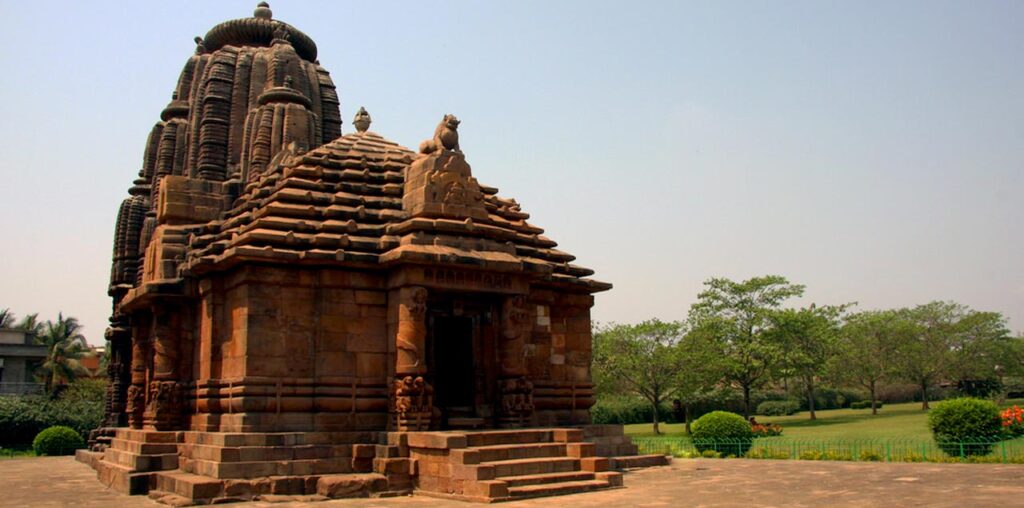Bhubaneswar, often known as the “Temple City of India,” is home to a spectacular ensemble of ancient temples, each having its own historical and architectural distinctiveness. Of all the places of reverence in Bhubaneswar, the Rajarani Temple is the most exquisite specimen of Kalinga architecture. Located just a few kilometres from the heart of the city, this ancient temple is not only a place of worship but also an architectural gem that attracts devotees and tourists from all over the world.
Historical Importance of Rajarani Temple
Rajarani Temple Bhubaneswar Odisha is a masterpiece of 11th-century Kalinga architecture, built during the reign of the Somavamsi dynasty. Though dedicated to Lord Shiva, this structure is noteworthy as it possesses an entirely different architectural setup from that of most temples around. It has been subject to much debate concerning the specific date or period in which it was erected, although there is considerable historical evidence suggesting its construction in approximately the 11th century with possible restorations afterwards.
The historical significance of the Rajarani Temple, Bhubaneswar, comes not only from its great architecture but also from its connection with the Kalinga style of temple building. This style is typified by the curvilinear spire, intricate carvings on temple walls, and the concentration of sandstone as the main material used. The temple is constructed using Rajarani stones, a particular kind of sandstone, which is said to be soft and pliable when it is quarried but hardens over time, making it perfect for intricate carvings and sculptures. The name “Rajarani” is derived from these unique sandstone blocks.
Architectural Beauty of Rajarani Temple
The Rajarani Temple Bhubaneswar is a magnificent example of the architectural skills of the Kalinga craftsmen. The temple’s design has an exquisite receding tower, often known as Shikhara, that touches around 18 meters in the sky along with intricately carved walls and pillars. Unlike many other temples of Odisha that are specific to different deities, the Rajarani Temple houses no specific idol. This temple was originally dedicated to Lord Shiva, but over the centuries, the sanctum has remained empty, which has led to much speculation about its original purpose.
The outer walls of the temple are decorated with a wide variety of sculptures, depicting various deities, dancers, animals, and celestial beings. These carvings are not only beautiful but also represent the craftsmanship and artistic creativity of the temple builders. The temple has several beautifully sculpted panels that depict scenes from Hindu mythology, making it a remarkable place for history enthusiasts and art lovers to explore.
Another striking feature of the Rajarani Temple Bhubaneswar Odisha is the pillars and the sanctum arrangement. The temple adheres to the classic design of a Kalinga-style temple, wherein the inner sanctum, or garbhagriha, is positioned under a towering spire. The sanctum is accessed via a small porch with finely carved pillars, making for a perfect contrast between the inner sanctum and the external grandeur of the temple. The Shiva lingam was placed in a sanctum; that space, however, is left empty at present.
One of the most distinct features of the Rajarani Temple is its complete absence of the typical deities seen in other temples of Odisha. The temple’s architectural beauty is beyond dispute, but the lack of an idol has been a contributing factor to the mystery and appeal of this ancient structure. Experts believe that it could have been part of a royal complex or a community temple that was later abandoned.
Rajarani Temple Timings and Visitor Experience
If you are planning to visit Rajarani Temple Bhubaneswar, it is very important to know the temple timings. The Rajarani Temple is open for visitors each day with specified timings for morning and evening darshan (worship). The normal visiting hours are as follows:
Morning Timings: 6:00 AM to 12:00 PM
Afternoon Break: Closed from 12:00 PM to 4:00 PM
Evening Timings: 4:00 PM to 7:00 PM
These timings may vary slightly on special occasions like festivals or holidays, so it is best to check the official temple website or inquire locally before your visit.
The serene environment of the Rajarani Temple Bhubaneswar Odisha provides a beautiful opportunity for tourists to relax amidst the temple. The temple is situated in a quiet garden space where one can sit, contemplate, and see the architecture of the temple along with its natural beauty. This temple is not so crowded as some other major temples of Bhubaneswar.
The Rajarani Temple is a good sight to study for photography enthusiasts. Beautiful engravings, the tall spire, and the greeneries all around it give plenty of scope to visitors to sketch the ancient monument’s beauty in their camera.
Festivals and Cultural Significance
The Rajarani Temple does not conduct regular worship as is the case with some other Bhubaneswar temples, but it offers the services of its Hindu religion and culture. The main event held at the temple is the Rajarani Music Festival, which is an annual classical music and dance festival performed around the temple in the winter months. It hosts the greatest classical music and dance artists of India, which is one of the major attractions for visitors to witness the rich culture of Odisha.
The temple’s association with Lord Shiva also makes it a participant in the important Hindu festivals performed in the deity’s name. Although the temple itself does not host elaborate celebrations, tourists can experience the cultural life of Odisha during these events, such as the Maha Shivaratri and Mahashivaratri festivals, when pilgrims from the entire region visit to worship Lord Shiva.
How to Reach Rajarani Temple Bhubaneswar
Rajarani Temple is about 5 km distance from Bhubaneswar city centre and can be accessed with ease through private and public transport. The temple is based near National Highway 16 which connects the city to other parts of Odisha. The visitors can hire taxis or take auto-rickshaws to reach the temple. The railway station and Biju Patnaik International Airport of Bhubaneswar are also well connected to major cities in India for those travelling by train or flight.
If you are travelling to Rajarani Temple Bhubaneswar Odisha, it is a good idea to plan your trip along with visits to other nearby landmarks such as the Lingaraj Temple, Mukteshwar Temple, and Udayagiri and Khandagiri Caves, which are all located within a few kilometers from the temple.
Conclusion
Rajarani Temple in Bhubaneswar is a wonderful example of Kalinga architecture and a very important part of Odisha’s rich cultural and religious heritage. Attraction and carvings of this temple, attached with Lord Shiva, and are indeed a point of attraction both for the people of faith as well as lovers of art attract each other and become a must-go place for a perfect moment when people want to see the peace that ancient architecture provides in India. People visit Rajarani Temple Bhubaneswar Odisha, whether it be for some moment of faith, or perhaps a moment for reflection, it indeed is something worth remembering forever.
If you are planning a visit, don’t forget to check the Rajarani Temple timings because the serene atmosphere and captivating beauty of the temple are best experienced during the quieter hours of the day.



